Tales of Treasure
Tales of HP Treasure Hunting
The content of the museum is very interesting to some people. The paths that museum pieces take to come here are often stranger than the items themselves. Below are tales of some of these paths. Of course, for every successful tale, there are 40 or 50 dead ends.
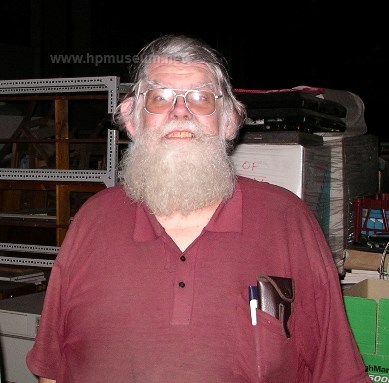
John Geremin of the Australian Computer Museum Society.
- Australian Computer Museum Society. This organization has contributed about five percent of the museum’s content. The ACMS is a collection of (primarily) former DEC heads. For years, the ACMS collected old computer items and stored them in a large, full warehouse of over 15,000 square feet. Almost none of the items were catalogued and there was no particular storage methodology (eg by vendor, item type, etc). So, finding items was a matter of digging through piles and opening boxes (in the massive warehouse) to see what might be there. Fortunately, there were many needles in the large haystack, so useful (HP) items could always be found. Some of the things I found there included: 9874A digitizer, 2114B data sheet, 2114B service manual, 9863A paper tape reader, boxes of 2000 paper tapes and many, many others. The ACMS has been a wonderful friend of the HP Computer Museum (particularly our "mentor" John Geremin). Unfortunately (a great tragedy, really), the ACMS lost its subsidized storage facility in 2005 and had to dispose of over 90% of its collection. Fortunately, most the good items (HP) found their way to the HP Computer Museum.
- In 2002, I got a phone call from (that great computer historian) Max Burnett of the ACMS. One of his associates had been given an HP 2700 “something”, and Max wondered what it was. I told him I had never heard of it, so it was probably an old HP instrument (which we don’t collect). A year later, I was finalizing the museum’s collection of HP catalogs, and I came across the 2700 in the 1984 edition. Sure enough, this thing was a computing product, although I couldn’t tell if it was a stand alone computer or a terminal (it’s both actually). 2700s are extremely rare, so I called Max so I could get in contact with his associate. This item had been donated to Monash University in the care of Judy Sheard who was in the process of putting together an old computer collection for the University. The 2700 had been donated by Roger Oakden. Roger had worked for HP when the 2700 was introduced. HP Australia had a demo unit, but never actually sold any 2700s to customers. When the product was discontinued, Roger bought it as a curiosity from his employer for $100. As is usually the case, the 2700 just sat around for the next 18 years. Roger was more than happy for us to take the unit for display. It was in working condition and included software and manuals. We archived the manuals and software and also made a video recording of the animated demo program.
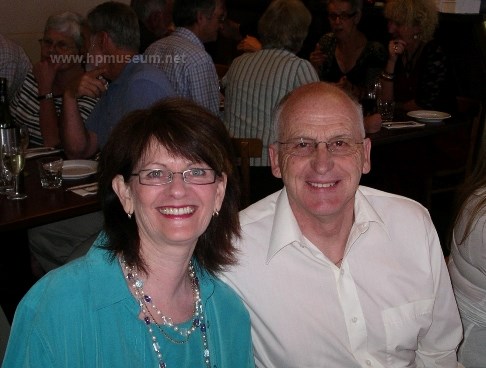
Judi and Robert Dey.
- In 1997, HP Austalia celebrated its 30th anniversary. The celebration included a display of old computer equipment that HPA had assembled from various sources. The museum was in its infancy, and we contributed a dozen or so items. One of the displays was a working 9845 that ran an animated screen saver program. Several years later, I tracked down Robert Dey who owned the machine. He had worked for HP in the early 1980s, and I had seen his business card attached to some of the manuals in our shelves. As it turned out, Robert had 3 9845s at his home. He donated a 9845T to us along with some peripherals. He also donated 10 boxes of 8” floppy discs. One of those boxes had discs which held copies of many of the 9845 application software tapes. These tapes, along with the 9845 tape drives are extremely unreliable (at this age). The floppy discs however are very robust. We were able to make archive copies of the software from these floppies. As happens often, an original HP 2116 computer that had formed part of the 1997 display had been thrown out by an overzealous facilities manager.
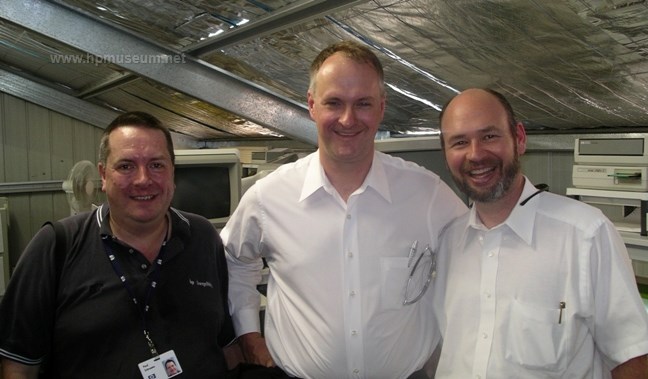
Paul Schroeter with Tom Huibregtse and Bob.
- HP employees have been wonderful supporters of the museum. Eric Lording brought us a 9820A and a 9825B after one visit to the Air Force in Canberra. Paul Schroeter has donated many items to the museum including most of our CE Service Handbooks. One day, Paul brought me an extremely rare 7310A printer with all documentation. This printer had a very short market life in the 1980s, but HP’s service organization had to keep a unit on hand for support purposes. Since the printer was now more than 15 years out of its service life, the museum was a good place for it. David Booth has also been a wonderful supporter of the museum. His specialty was pack-ratting old product posters (which now hang proudly in the museum). My former company’s account manager, Chris Bor, is the one who gave us most of the old HPA TV commercials in our collection. Russell Warmington gave us our first HP-86 along with peripherals and software.
- Extortion is not a very effective means of item acquisition. One of my favorite customers, The Australia Diary Corporation gave us their 3000/58 along with peripherals when it was retired. But, they didn’t give us the even older 9845 that we wanted at the time. They had some old quality information stored on 9845 tapes that they needed to keep. After a couple of years pestering my good friend and IT manager Ian Caine, I finally suggested to him that “It would be a shame if the market were to somehow become aware that the ADC was using 20 year old IT equipment that wasn’t year 2000 compliant……….not that I would ever say anything.” Ian laughed and told me to go away, like they all do. Six months later, we finally got the old machine, which didn’t work anyway.
- In 2004, I bought a 9875A tape drive from a Canadian company that sold second hand T&M gear. Of course, it didn’t come with any manuals and I couldn’t find any anywhere. I did a Google search and only got a few hits for this obscure product. I dutifully looked into each entry and each led nowhere. One of the entries was a very long list of documentation that had been donated to a museum somewhere a few years ago. As chance would have it, the museum was located right here in Melbourne, the Scienceworks Museum. They don’t really display old computers there, so I thought it was unlikely that they would have kept this manual. But, to be thorough, I sent them an email to enquire and thought that would be the end of it. About 7 weeks later I got a reply. Yes, they did remember the donation; they had in turn donated the items to the “Communications Museum”. The Communications Museum is a collection of old telephone and switching equipment, also in Melbourne. It is staffed by former employees of Australia’s monopoly telecommunications carrier. I knew the manual I was looking for would be of no use to them, but I made contact with slim hopes of success. Bob Muir contacted me and confirmed that they still had the pallets of books that Scienceworks had sent to them. I was welcome to come by and wade through them. The three pallets were neatly packed (though not labeled) and were covered in much less dust than I was used to. I succeeded in finding three different 9875A manuals and a lot of other treasure as well, including: 2752A service manual, 264X plug in board service manuals, 9825 service manual, and more.
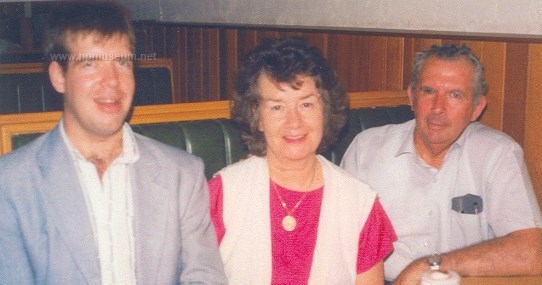
Joy Coombe and Family.
- Sometimes people will call HP because they have an old item that they’d like to “give back” for posterity. HP has no use for this junk, so they will often refer the caller to the museum. Most of these calls are for very common printers which are only 10 to 15 years old. One of the “old printer” referrals I got from HP turned out to be much more. I called Mrs Coombe who lived in Queensland. Sure enough, she had an old printer, and it was a “real” old printer, a 9871A. Not only that, she also had a 9830, a 9870 and a 9880. I explained that some of the items would have some residual “eBay value”, but she insisted on giving everything to the museum. She also arranged to pack and ship the goods. When the pile arrived, I noticed it also contained an interface for the rare 9861A typewriter printer. I called Mrs Coombe to see if she still had it. Unfortunately, she had given it to another person years ago who wanted to remove all the printer’s screws (I don’t question what is weird or normal anymore). The dear Mrs Coombe called me the next day to say that she now had the internal pieces of the old printer AND the bag of screws, which she duly sent to me. The 9830 we received from Mrs Coombe may also be a world record holder. It was used in a BUSINESS application continuously for over 25 years. Not many other computers could make that claim. And certainly no other business computer could have possibly served longer after having been completely inundated in a flood as Mrs Coombe’s 9830 had been in 1974.
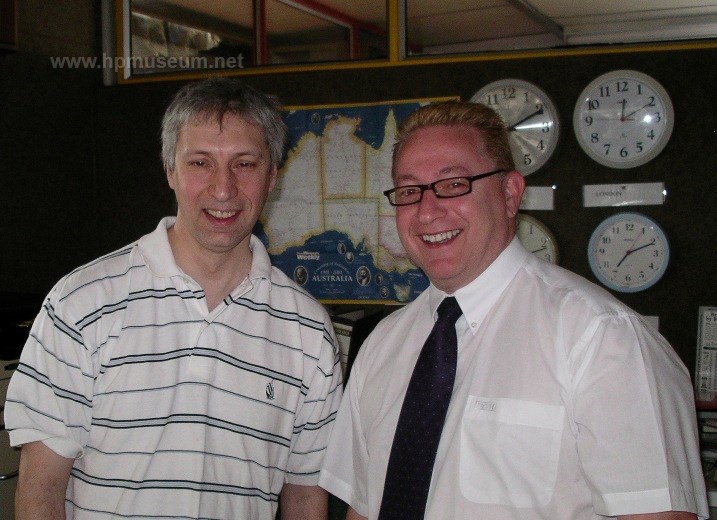
Bernie Lebenbaum and Michael Caplan of MacService.
- Companies that sell second hand test and measurement equipment are often good places to finding old HP computer gear. Old HP technical computers were often used as controllers for T&M equipment. The Macservice Group in Melbourne is a good example. They have heaps of old T&M gear stashed in every corner and rack location in the warehouse. Through my rummaging, I found countless treasures including: rare 9837 computer, 9835, keyboard for a 9915 (just sitting in an unrelated pile), 9845 service manual, and many others.
- Another good source of items is cold dark corners in warehouses where it’s not entirely clear who has responsibility for things that have been there for a very long time. I have found numerous treasures in HP warehouses over the years. The best find occurred at HP Australia’s Blackburn warehouse in 2003. This warehouse was HP’s main distribution centre from 1974 to 1991. It was far too small for commercial distribution in the 1990s and was used for demo equipment, service parts, marketing items and odds and ends. While fishing around in the farthest corner of the mezzanine level, I came across an old pallet of documentation. On this pallet, I found an almost complete collection of HP Measure Magazines and HP Journals (starting from the first issues of those publications – 1949 in the case of the HP Journal). This collection had started with Sample Electronics before the company was acquired by HP in 1967. The addressee labels carried the name of HP Australia’s first managing director (John Warmington) and the address of the building that Sample occupied in the early 1960s. HP had no ongoing use for the collection and was more than happy for me to take it away.
- Cold calling is another fun way to acquire items. Someone who knows the museum will sometimes stumble accross someone else who has or once had some old HP computer. So, we make telephone calls until we find the person in the know (or reach a dead end). In 2002, we contacted the Kassulke Transport Company of the Riverland in South Australia on a reference. We had heard that Kassulke had once had an HP 250 computer. Our enquiry paid off. Kassulke no longer had the 250, but they did have a 260 that they were going to retire soon (along with a number of terminals and peripherals) and we were welcome to it upon retirement. Before Kassulke could complete their data migration from the 260, their only remaining hard disc failed. We lent the company one of our 7958 discs drives for six months so they could complete their transition. Kassulke is a small family-owned transport company in a fairly remote agricultural area. They decided to computerize their operations in the late 1970s long before anyone else in the area. They chose the HP 250. As expected, the computer system made the company more efficient. An unexpected benefit of the system was that it also greatly increased the resale value of the company’s trucks. The existence of the computerized maintenance records often added up to $10,000 to the resale value of each truck.
- The museum’s web site immediately became our number one source of referrals when it was launched in December of 2004. After learning of the museum on the web, Jay Anderen gave us some 700 Series workstations, an 800 Series server, a 7980 tape drive and an optical disc library. Shane McEwan of the Bureau of Meteorology gave us two racks full of HP1000 A700 equipment including computers, terminals, disc drives and tape drives. The web site has also allowed us to make friends all over the world – USA, South Africa, Japan, Europe, everywhere. Marc Mislanghe of France has two samples of one of the most obscure products ever made by HP – The 7510A film recorder. Marc donated his user manuals and promotional literature to the museum. In 2008, Sheila Isaacs of New York contacted us to donate an original 2116A (Yes "A" model) as well as a 2020 tape drive. These machines had been sitting in her garage since her company retired them 35 years prior.
- We have a great working relationship with Agilent here in Australia. They still have old HP technical computers that they used for lab and production line testing. They give us the old items (long) after they are sure they will never need them again. We picked up some 300 Series computers as recently as 2005. But, Agilent usually has old equipment for us that is too new to be useful in the museum. So, they let us trade this “new” stuff for old things that we can actually use. Our trading partner is Computer Applications in Sydney. Barry Silverton’s company is the largest remarketer of HP 3000 systems in Australia (among other things). Barry trades us really old items from his inventory (which he would never sell anyway) for these Agilent hand-me-downs (that he won’t be able to sell for much either). We have obtained some great items this way including early Vectra PCs, 3075A terminal, 2601A and 2603A printers. Barry also lets us copy all the promotional literature that he has which dates back to the early 1980s.
- One of the most unique pieces we have in the museum is an HP-01 calculator watch display case. This folding leather and glass case includes all of the components of the HP-01. It’s the most impressive marketing item I have ever seen from HP. It was given to us by Alan Warmington, grandson of HP’s first managing director in Australia – John Warmington.
- One of the rarest computers ever made by HP was the HP 300. This business machine was launched with great fanfare in the late 1970s, but it flopped spectacularly. Very few of these computers were ever made. They were not compatible with other HP computers, and HP never introduced a follow on product. For these reasons, the few customers who actually bought the 300 had very little reason to hang onto them upon retirement (and there was no second hand market). So, I was pretty happy when I stumbled upon Stan Sieler, San Francisco Bay Area businessman and collector. One of Stan’s web postings actually had a photograph of a real HP 300. This machine was nowhere near operational and it was missing many of its internal components. But, it was a REAL HP 300 and it looked okay. Stan accepted my offer to exchange an almost-working 9100 for his old dust-collector. Being the good sport that he is, Stan also threw in a 9895A, A900, 2105A, 9000/835 and a 9134B.
- Andy Stewart is one of the most enthusiastic people on the planet. Like most of the members of the Australian Computer Museum Society, he is a DEC buff. But, in his travels, he often comes across old HP computers, and he always calls me immediately. With the excitement of the call, you’d think a new baby had been born! Over the years, Andy has sent many items our way, including a 9845, several terminals and numerous software discs. Another Andy has also been a good contributor. That jack-of-all trades engineer Andrew Tweedle has unearthed several items for the museum including a 9920, Series 400 computers and old monitors. The best thing Andy ever brought to us was a 1304A analog monitor and the shell of a 1350A graphics translator. After researching the 1350A, I became transfixed by the machine and acquired a few working models. It soon came to be one of my favorite pieces in the entire museum.
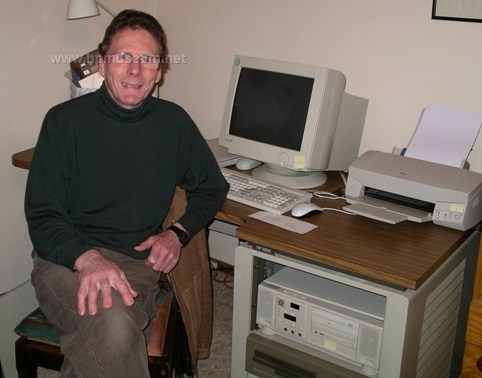
Chris Simpson with 9896 Desk.
- One of the most bizarre (and unlikely) treasure-hunting stories at the museum relates to the 9831A. This machine was one of the rarest computers ever made by HP. The museum is aware of only 2 units existing in the world (though there certainly must be more). In 2006, the museum bought the 98218A ROM for the 9831A (allowing the computer to connect to a 9885 disc drive), never thinking we would succeed in obtaining an actual 9831A. After considerable research, we assessed that the 9831A was likely to be identical to the 9825A except for the primary system ROM in each computer (BASIC for the 9831A and HPL for the 9825A). Later in 2006, a 9831A system ROM came up for bid on eBay, from our friends at Crisis Computer in San Jose. We succeeded in purchasing the ROM for about $55. When we got the system ROM to the museum, we were delighted to confirm that using the ROM in a 9825A actually turned that machine into a 9831A as we had hoped. Since we already had a 98218A ROM, we could also make our new 9831A communicate with a 9885 disc drive. However, we soon discovered that we also needed some software to allow our new system to actually initialize discs and to perform basic disc operations. We assessed that the likelihood of this software having survived anywhere was near zero. In 2003, we had separated our collection of 8” floppy discs into categories based on the type of computer they had been used with (9835/45, 9825, 3000, 1000, etc). We separated about 200 of these discs. Three of the 200 discs that we had separated had been marked as “9831 initialized”. These discs had come from one of our benefactors: Chris Simpson. We read each of these discs with our 9831A and to our astonishment found that one of them contained all of the system files required for the 9831A to communicate with the 9885 and perform all disc operations! Four years after I first visited Chris, I paid him another call. I remembered that he had an HP "computer desk". This desk ended up being the desk for the 9896 bundled computer (even rarer than the 9831A).
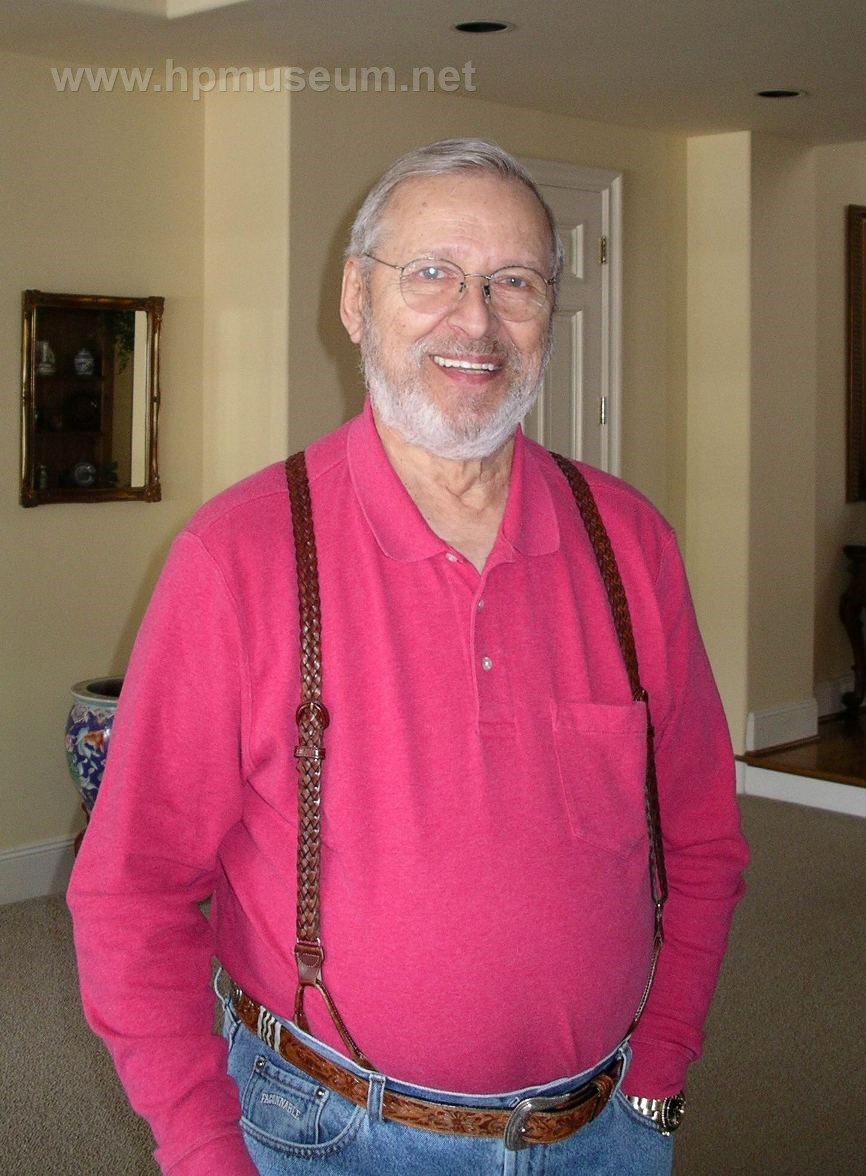
Stan Kurzet, founder of Infotek Systems.
- Stan Kurzet founded Infotek Systems in the 1970s to make add on products for HP technical desktop computers (from the 9830A to the 200/300 Series). A 10-year-old Stan escaped from occupied Poland with his father and 14-year-old brother in March of 1940. The trio traveled through Latvia to Sweden where they obtained Swedish travel papers from a Swedish diplomat whom Stan’s father had treated. The three then traveled through GERMANY to Italy where they caught a ship to Panama and then to the USA. The Germans occupied Paris only two weeks after Stan’s family had traveled through the city. Stan fixed radios during the war years and received formal electronics training in the US military in the 1950s before starting his various business ventures. I met Stan on the internet in 2003 while trying to figure out how to get modern audio tape cassettes to work in a 9830A tape drive. I visited Stan at his Newport Beach home in January of 2008. Stan is the most organized person I have ever met in conjunction with the museum project. Being a good pack rat (with a supportive wife), he kept many HP and Infotek items from the 1970s and 1980s. But, instead of the items being packed away in unlabelled boxes and covered with piles of dust (the “usual manner”), they were all unpacked and neatly arranged on racks in his very-clean storage shed. Stan donated a lot of very rare and interesting items to the museum including a 9837, 9861A typewriter, 98781A monitor, HP-125 software and many more (all of which were intact and working).
- In early 2009, I saw an ad on eBay for some 8-inch HP 250 discs. The ad was posted by a vendor who lived right here in Melbourne, so I sent him a note. Greg McKay had acquired a 250 as his first computer in the early 1990s to program and play with (this is very serious "playing" for a first computer). He had disposed of his 250 years ago, but he had a lot of other things that were still collecting dust in storage below his house. That treasure trove included a 3000/42, two 7925 disc drives and two 2631A printers (all of which Greg donated to the museum). Some of the 250 software discs were new to us including the GPL disc and the B.05 Utilities disc.
- In early 2011, I got an email from Adolf Specht of Vancouver, Canada. Adolf had worked for HP for awhile in the 1970s. After leaving HP, he started his own business working with HP products, primarily the 9830 desktop computers. Like many museum donors, Adolf is a great pack rat. He kept a lot of his leftover equipment stored in his home for a few decades. Being a 9830 expert, Adolf had a wonderful collection of equipment from Infotek (Stan Kurzet's company from two paragraphs above). In addition to numerous ROMs and interfaces, Adolf also had Infotek disc drives and printers. The pallet we received from Adolf was meticulously packed. Instead of using crumpled newspaper or packing foam, Adolf used paper towles. So the museum now also has a lifetime supply of paper towels.
- In January of 2011, John Geremin of the Australian Computer Museum Society organised a visit to the museum by some old computer buffs in Melbourne. Ian Lawrence of Alcoa came along and dropped off an HP-85 and some other pieces for us. At the end of the year, Ian contacted me to let me know that Alcoa was decommissioning a 3000/928 soon and we were welcome to take it. A few months later, I visited Alcoa to pick up the 3000. Ian gave me a tour of the place along with Keith Davey. Alcoa still had a lot of old HP gear in use and on standby including HP1000/A900, 7974A tape drive, old disc drives and terminals. I can't help sticking my nose into everything when I get into a room of old HP computer equipment. Tucked away in the corner, I found a decommissioned, dust-covered 13279B monitor (introduced in 1983). This was HP's first high-resolution, large-screen display (made by Conrac Corporation). The HP-branded models are very rare. Naturally, I wanted to take the monitor, but it was officially on standby, so not available. After lending Alcoa a couple of spare SCSI cards for their A900, I managed to convince them to trade me the 13279B for a couple of 700 Series terminals (which they actually needed) in early 2013. After a lot of fiddling and adjusting, we were able to get the old monitor going with a 200 Series computer. Alcoa has been a terrific supporter of the museum.
- In May of 2013, I got an email from Danny Vandepol in Belgium. He wondered if I was interested in an old HP computer that was currently stored in his parents attic. He sent me some photos, and the computer was a 2114B along with a 2761A card reader, 2748 paper tape reader and a Teletype 33 machine. This computer had been used at Danny's university in the 1970s. It was stored there in the mid 1970's when it stopped working. Danny bought it from the university in the early 1980s for almost nothing. He fixed it and played with it for awhile before it was retired again at the folks place for the next 30 years. The ever-helpful Rik Bos worked with Danny to get the gear crated and shippped to Melbourne from Amsterdam. The 2114B arrived in pristine cosmetic condition, better than anything I had ever seen. The Teletype machine was the same. Both items looked like they were only a few years old. Even better, the 2114B had only one minor operational problem on its front panel.
| Back |
^ TOP©2004 - 2024 BGImages Australia - All Rights Reserved.
The HP Computer Museum and BGImages Australia are not affiliated with HP Inc. or with Hewlett Packard Enterprise. Hewlett Packard and the HP logo are trademarks of HP Inc and Hewlett Packard Enterprise. This website is intended solely for research and education purposes.
